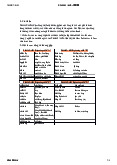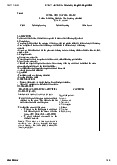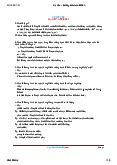







Preview text:
20:43 29/7/24 Reading Reading Passage 1
You should spend about 20 minutes on Questions 1 -13 which are based on Reading Passage 1 below.
Nushu — A Secret Language
A. lt is sometimes said that men and women communicate in different languages. For
hundreds of years in the Jiangyong County of Hunan Province, China, this was quite
literally the case. Sometime between 400 and 1,000 years ago, women defied the
patriarchal norms of the time that forbade them to read or write and conceived of Nu shu
— literally, * women's language * — a secretive script and language of their own. Through
building informal networks of ‘sworn sisters’ who committed themselves to teaching the
language only to other women, and by using it artistically in ways that could be passed off
as artwork (such as writing characters on a decorative fan), Nushu was able to grow and
spread without attracting too much suspicion.
B. Nushu has many orthographical distinctions from the standard Chinese script.
Whereas standard Chinese has large, bold strokes that look as if they might have been
shaped with a thick permanent marker pen, Nushu characters are thin, slanted and have
a slightly ‘scratchy’ appearance that bears more similarity to calligraphy. Whereas
standard Chinese is logographic, with characters that represent words and meanings,
Nushu is completely phonetic — each character represents a sound; the meaning must
be acquired from the context of what is being said. Users of Nushu developed coded
meanings for various words and phrases, but it is likely that only a tiny fraction of these
will ever be known. Many secrets of Nushu have gone to the grave.
C. Nushu was developed as a way to allow women to communicate with one another in
confidence. To some extent, this demand came from a desire for privacy, and Nushu
allowed women a forum for personal written communication in a society that was
dominated by a male-orientated social culture. There was also a practical element to the
rise of Nushu, however: until the mid 20th century, women were rarely encouraged to
become literate in the standard Chinese script. Nushu provided a practical and easy-to-
learn alternative. Women who were separated from their families and friends by marriage
could, therefore, send ‘letters’ to each other. Unlike traditional correspondence, however,
Nushu characters were painted or embroidered onto everyday items like fans,
pillowcases, and handkerchiefs and embodied in ‘artwork’ in order to avoid making men suspicious.
D. After the Chinese Revolution, more women were encouraged to become literate in the
standard Chinese script, and much of the need for a special form of women’s
communication was dampened. When the Red Guard discovered the script in the 1960s, about:blank 1/8 20:43 29/7/24 Reading
they thought it to be a code used for espionage. Upon learning that it was a secret
women's language, they were suspicious and fearful. Numerous letters, weavings,
embroideries, and other artefacts were destroyed, and women were forbidden to practise
Nushu customs. As a consequence, the generational chains of linguistic transmission
were broken up, and the language ceased being passed down through sworn sisters.
There is no longer anyone alive who has learnt Nushu in this traditional manner; Yang
Huanyi, the last proficient user of the language, died on September 20, 2004, in her late 90s.
E. In recent years, however, popular and scholarly interest in Nushu has blossomed. The
Ford Foundation granted US$209,000 to build a Nu shu Museum that houses artefacts
such as audio recordings, manuscripts, and articles, some of which date back over 100
years. The investment from Hong Kong SAR is also being used to build infrastructure at
potential tourist sites in Hunan, and some schools in the area have begun instruction in
the language. Incidentally, the use of Nushu is also a theme in Lisa See's historical novel.
Snow Flower and the Secret Fan, which has since been adapted for film. about:blank 2/8 20:43 29/7/24 Reading Questions 1-5
Choose the correct heading for each section from the list of headings below. i. Financial costs ii. Decline and disuse iii. Birth and development iv. Political uses of Nushu v. The social role of Nushu vi. Last of the Nushu speakers vii.
Characteristics of written Nushu viii.
Revival and contemporary interest 1 Section A iii 2 Section B vii 3 Section C v 4 Section D ii 5 Section E viii Questions 6 & 7
Choose TWO letters, A-E. Write your answers in boxes 6 and 7 on your answer sheet.
Why was there a need for Nushu? Which TWO reasons are given in the text?
A. It provided new artistic opportunities for female artisans.
B. It was a way for uneducated women to read and write.
C. Not enough women were taking an interest in literature.
D. It was a way for women to correspond without men knowing.
E. It helped women believe in themselves and their abilities. about:blank 3/8 20:43 29/7/24 Reading Questions 8-13
In boxes 8-13 on your answer sheet, write
TRUE, if the statement agrees with the information
FALSE, if the statement contradicts with the information
NOT GIVEN, if there is no information on this
8 The post-Revolution government did not want women to read or write in any language. NG
9 At first, the Red Guard thought Nushu might be a tool for spies. T
10 Women could be punished with the death penalty for using Nushu. NG !
11 The customary way of learning Nu Shu has died out. T
12 There is a lot of money to be made out of public interest in Nushu. NG
13 Nushu is now being openly taught. T about:blank 4/8 20:43 29/7/24 Reading READING PASSAGE 2
You should spend about 20 minutes on Questions 14-25 which are based on Reading Passage 2 below.
Bricks – The Versatile Building Material
Bricks are one of the oldest known building materials dating back to 7000 BCE. The
oldest found were sun-dried mud bricks in southern Turkey and these would have been
standard in those days. Although sun-dried mud bricks worked reasonably well, especially
in moderate climates, fired bricks were found to be more resistant to harsher weather
conditions and so fired bricks are much more reliable for use in permanent buildings.
Fired brick are also useful in hotter climates, as they can absorb any heat generated
throughout the day and then release it at night.
The Romans also distinguished between the bricks they used that were dried by the sun
and air and the bricks that were fired in a kiln. The Romans were real brick connoisseurs.
They preferred to make their bricks in the spring and hold on to their bricks for two years,
before they were used or sold. They only used clay that was whitish or red for their bricks.
The Romans passed on their skills around their sphere of influence and were especially
successful at using their mobile kilns to introduce kiln-fired bricks to the whole of the Roman Empire.
During the twelfth century, bricks were introduced to northern Germany from northern
Italy. This created the ‘brick Gothic period,’ which was a reduced style of Gothic
architecture previously very common in northern Europe. The buildings around this time
were mainly built from fired red clay bricks. The brick Gothic period can be categorised by
the lack of figural architectural sculptures that had previously been carved in stone, as the
Gothic figures were impossible to create out of bulky bricks at that time.
Bricks suffered a setback during the Renaissance and Baroque periods, with exposed
brick walls becoming unpopular and brickwork being generally covered by plaster. Only
during the mid-eighteenth century did visible brick walls again regain some popularity.
Bricks today are more commonly used in the construction of buildings than any other
material, except wood. Brick architecture is dominant within its field and a great industry
has developed and invested in the manufacture of many different types of bricks of all
shapes and colours. With modern machinery, earth moving equipment, powerful electric
motors and modern tunnel kilns, making bricks has become much more productive and
efficient. Bricks can be made from a variety of materials, the most common being clay,
but they can also be made of calcium silicate and concrete. about:blank 5/8 20:43 29/7/24 Reading
Good quality bricks have major advantages over stone as they are reliable, weather
resistant and can tolerate acids, pollution and fire. They are also much cheaper than cut
stonework. Bricks can be made to any specification in colour, size and shape, which
makes them easier to build with than stone. On the other hand, there are some bricks that
are more porous and therefore more susceptible to damage from dampness when
exposed to water. For best results in any construction work, the correct brick must be
chosen in accordance with the job specifications.
Today, bricks are mainly manufactured in factories, usually employing one of three
principal methods – the soft mud process, the stiff mud process and the dry clay process.
In the past, bricks were largely manufactured by hand, and there are still artisanal
companies that specialise in this product. The process involves putting the clay, water
and additives into a large pit, where it is all mixed together by a tempering wheel, often
still moved by horse power. Once the mixture is of the correct consistency, the clay is
removed and pressed into moulds by hand. To prevent the brick from sticking to the
mould, the brick is coated in either sand or water, though coating a brick with sand gives
an overall better finish to it. Once shaped, the bricks are laid outside to dry by air and sun
for three to four days. If these bricks left outside for the drying process are exposed to a
shower, the water can leave indentations on the brick, which, although not affecting the
strength of the brick, is considered very undesirable. After drying, the bricks are then
transferred to the kiln for firing and this creates the finished product. Bricks are now more
generally made by manufacturing processes using machinery. This is a large-scale effort
and produces bricks that have been fired in patent kilns. ieltsxpress
Today’s bricks are also specially designed to be efficient at insulation. If their composition
is correct and their laying accurate, a good brick wall around a house can save the
occupants a significant amount of money. This is primarily achieved today through cavity
wall insulation. Insulating bricks are built in two separate leaves, as they are called in the
trade. The gap between the inner and outer leaves of brickwork depends on the type of
insulation used, but there should be enough space for a gap of twenty millimetres
between the insulating material in the cavity and the two leaves on either side. The air in
these gaps is an efficient insulator by itself. Cavity walls have also replaced solid walls,
because they are more resistant to rain penetration. Because two leaves are necessary, a
strong brick manufacturing industry is essential, so that enough good quality insulating
bricks are plentifully available. about:blank 6/8 20:43 29/7/24 Reading Questions 14-18
Do the following statements agree with the information given in the text? Write:
TRUE if the statement agrees with the information
FALSE if the statement contradicts the information
NOT GIVEN if there is no information on this
14 Fired bricks are not efficient in countries with hot weather, as they absorb too much heat. F
15 Roman brick production was determined by which season it was. T
16 The bricks that led to the brick Gothic period in northern Germany were popular with house builders. NG
17 Buildings showing brickwork were generally not liked during the Renaissance. T
18 Some types of bricks can soak up too much water due to their absorbent qualities. T Questions 19 – 24
Complete the flow chart below. Write NO MORE THAN TWO WORDS from the text for each answer. Making Hand-made Bricks
Combine the 19 clay water and other ingredients with a 20 tempering wheel to the desired consistency.
Using the hand, fill 21mould with the mixture-coat with 22sand (provides a better finish)
or water to prevent stickiness.
Dry in the sun; try to avoid rain, which will cause marks in the bricks – this will no affect
the bricks’ 23strength
Fire the brick in a (24) kiln about:blank 7/8 20:43 29/7/24 Reading Questions 25 & 26
Label the diagram below. Write NO MORE THAN TWO WORDS AND/OR A NUMBER about:blank 8/8




